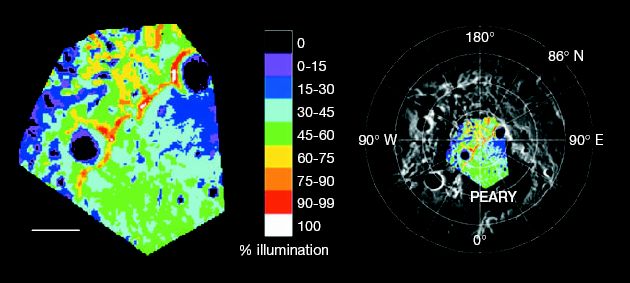Perfect Spot Found for Moon Base

Researchers have identified what may be the perfect place for a Moon base, a crater rim near the lunar north pole that's in near-constant sunlight yet not far from suspected stores of water ice.
Permanently sunlit areas would provide crucial solar energy for any future Moon settlement, a goal for NASA outlined last year by President George W. Bush. Such sites would also have resort-like temperatures compared with other lunar locations that fluctuate between blistering heat and unfathomable cold.
Equally important, in the permanently shadowed depths of craters around the lunar north pole, water ice may lurk, according to previous but unconfirmed observations.
Melted, it would be vital for drinking. Broken into hydrogen and oxygen, the water could provide breathable air and be used to make rocket fuel for a trip to Mars.
That fits in neatly with the White House vision of using the Moon as a stepping stone to Mars.
Hot real estate
The best spot to settle on the Moon may be on the northern rim of Peary crater, close to the north pole, says Ben Bussey of Johns Hopkins University. The analysis, to be published in the April 14 issue of the journal Nature, is based on 53 images from the spacecraft Clementine, which orbited the Moon for 71 days in 1994.
| Image Gallery THE MOON |
Unlike Earth, whose extreme tilt causes seasons, the Moon's rotational axis is almost perfectly upright, deviating just 1.5 percent from the main plane of the solar system that extends outward from the Sun's belly. On Earth, summer means constant sunlight at the North Pole, and winter plunges the Arctic into permanent darkness. But on the Moon, theorists have long suspected there might be high points from which the Sun is always visible.
Because the Moon has virtually no atmosphere, temperature fluctuate wildly from day to night, from about 212 degrees Fahrenheit (100 Celsius) to minus 292 Fahrenheit (-180 Celsius) near the equator.
Other scientists have estimated that temperatures on any possible permanently lit spot would be comparatively balmy, though still a frigid minus 58 Fahrenheit (-50 Celsius), give or take a little.
"A region with this relatively benign temperature range represents an attractive site for building hardware designed for long-term use," Bussey and his colleagues write.
The researchers produced an illumination map of the polar region. The Peary crater, created long ago by the impact of an asteroid, is about 45 miles (73 kilometers) wide.
Questions remain
Craters near the south pole have also been previously discussed for a possible Moon base. Those are not highlighted by any constantly illuminated spots, the same research group concluded previously. Even so, the north polar region needs further analysis before NASA can decide where to go first.
Clementine was in a position to see the lunar north pole for only brief periods of the northern summer. So Bussey's team had had to make assumptions about the extent of winter sunlight.
"With the information available, it is not possible to state definitively that these areas are permanently sunlit because the data correspond to a summer rather than a winter day," the scientists report. "But we can be certain that they are the most illuminated regions around the north pole and that they are also the areas on the Moon most likely to be permanently sunlit, given that there are no constantly illuminated areas in the south polar region."

The south polar sites are not ruled out, however, since sunlight is no more important than water.
"It's a combination of those two things that determines which pole you'll visit first," Bussey said in a telephone interview.
The European Space Agency's SMART-1 craft, currently orbiting the Moon, is expected to shed additional light on lunar topography. NASA plans a robotic reconnaissance effort in 2008 that would provide more information on polar illumination. Meanwhile, India's first mission to the Moon, planned for 2007, would pack a U.S.-made radar instrument designed to pin down the locations of water ice.
Bussey said water ice might be found to be equally distributed at both poles, or it may exist only in select craters.
- Moon News & Lore
- Top 10 Cool Moon Facts
- Overview of Moon Exploration Plans
- 24 Hours of Chaos: The Day The Moon Was Made
Join our Space Forums to keep talking space on the latest missions, night sky and more! And if you have a news tip, correction or comment, let us know at: community@space.com.
Get the Space.com Newsletter
Breaking space news, the latest updates on rocket launches, skywatching events and more!

Rob has been producing internet content since the mid-1990s. He was a writer, editor and Director of Site Operations at Space.com starting in 1999. He served as Managing Editor of LiveScience since its launch in 2004. He then oversaw news operations for the Space.com's then-parent company TechMediaNetwork's growing suite of technology, science and business news sites. Prior to joining the company, Rob was an editor at The Star-Ledger in New Jersey. He has a journalism degree from Humboldt State University in California, is an author and also writes for Medium.
Most Popular

